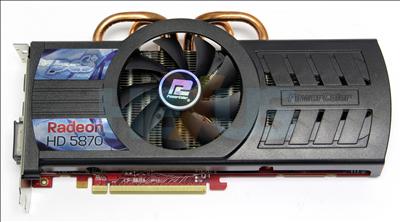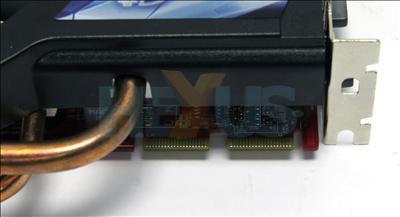The card
PowerColor's Radeon HD 5870 range includes the default-clocked model, operating at the standard 850MHz core and 4,800MHz memory. Then there's the watercooled model, LCS HD 5870, that ships with 875MHz/5,000MHz frequencies.Now ensconced between the two is the PCS+, cooled by a custom heatsink and clocking in at 875MHz core and 4,900MHz memory. What's clear is that headroom on the HD 5870 GPU is very limited, as there's scant difference between the three cards.
Here is the PCS+ in all its glory. PowerColor uses the same cooler on its pre-overclocked Radeon HD 5850, too.
Using a heatpipe-driven approach to wick away the heat, the card's cooler is truly huge. The heatpipes, due to how they protrude from the PCB, may cause a problem in the odd chassis.
The plastic covering hides the mass of aluminium fins that are connected to the four heatpipes which, in turn, hook up to the copper insert that makes contact with the underlying GPU.
Weighing in at 688g, it's not quite as heavy as the 727g Sapphire Vapor-X and certainly a lot lighter than the reference card that tips the scales at 958g.
Noise-wise, the cooler is effectively silent when the card throttles down in 2D. It's also quieter than either the Sapphire Vapor-X or reference model when under prolonged load, and that, we reckon, is the main reason for it, rather than outrageous clock-speeds.
We've received word that it should retail for about £360, which represents a £40 premium over the basic HD 5870s.
The PCB's pretty generic, though. What you can see here is the standard six-and-six-pin power setup in the foreground. Further back are the additional heatsinks that cool the VRMs. Bear in mind that the eight RAM chips aren't cooled by the heatsinks, and that's an oversight on a custom-cooled card.
The rear-mounted outputs are exactly the same as most other HD 5870's. This means three distinct digital outputs: DVI, HDMI, and DisplayPort. All three can be used simultaneously, although DisplayPort needs to be one of the trio of outputs unless using an active adapter.
Bundling is as basic as it gets, however, and is something that PowerColor should address on what is a premium card.

















